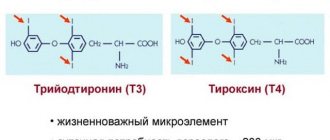How is hyperprolactinemia treated?
A stable increase in prolactin is a reason to consult a doctor.
A blood test can confirm or refute the suspicion of this disease. You will have to take it at least twice a month. Since the female body produces hormones cyclically, their quantity is constantly changing and the analysis is taken at different phases of the menstrual cycle. This way, the attending physician will be able to obtain the most reliable picture of the patient’s hormonal background. After which treatment will be prescribed:
- drug therapy
- radiation therapy
- Severe cases of the disease may require surgical intervention.
Reasons for increased prolactin
Factors that provoke an increase in prolactin in the blood can be divided into 3 groups - these can be physiological, pathological and caused by taking medications.
Among the medications, prolactin levels increase:
- neuroleptics (Aminazin, Truxal, Triftazin and others);
- Levodopa;
- Verapamil;
- hormonal contraceptives;
- antiemetics (Reglan, Avioplant, Sulpiride);
- Reserpine;
- opiate drugs (Morphine, Tramadol, Nalorphine).
Physiological reasons for increased hormone levels:
- pregnancy;
- lactation period;
- starvation;
- dream;
- stressful situations;
- after eating foods rich in protein;
- physical activity (work, sports);
- intimacy.
Pathological causes of increased prolactin:
- pathologies of the pituitary gland, in particular prolactinoma;
- polycystic ovary syndrome;
- diseases of the hypothalamus;
- lesions of the chest, for example, surgical interventions, trauma;
- liver or kidney failure;
- hormone-producing ovarian tumors;
- primary hypothyroidism;
- idiopathic hyperprolactinemia.
As labor approaches, the level of estrogen in the blood increases, which increases the concentration of prolactin. It reaches its maximum value by week 25, increasing significantly compared to the first trimester.
Before birth, the content of lactogenic hormone decreases slightly, and with the start of feeding it increases again.
A prolactin test is indicated for:
- Disruptions of the menstrual cycle;
- Infertility;
- Decreased sexual desire;
- Delayed sexual development in girls;
- Galactorrhea (milk secretion outside the period of breastfeeding);
- Tumors of the hypothalamus or pituitary gland.
Effective treatments
A doctor can prescribe treatment only after establishing the cause of increased prolactin. With physiological hyperprolactinemia and a slight jump in hormone levels, no special treatment is required. If the problem is caused by pathological changes in the body, then individual therapy is prescribed, depending on the cause and severity of the pathology. It is important for a woman to restore ovulation, especially if she plans to have children.
READ ALSO: Clinical manifestations of elevated prolactin in men: physiological and pathological causes, options for reducing levels
Among the drugs used to combat hyperprolactinemia, drugs containing ergot alkaloid are highly effective:
- Dostinex;
- Cabergoline;
- Bromocriptine.
The course of taking such medications can last for several years. Sometimes you have to take medications for the rest of your life. The dosage of drugs can be adjusted based on the results of control tests.
In the presence of tumor formations that provoke an increase in prolactin, surgery and radiation therapy are recommended. Access to the tumor is usually carried out transnasally. Today, craniotomy is used extremely rarely.
Diet and nutritional habits
With slight increases in prolactin, you can adjust its level by changing your diet. It is very useful to eat foods fortified with folic acid. It helps to quickly absorb proteins, the excess of which often causes hyperprolactinemia.
It is recommended to include in the diet:
- fatty fish;
- liver;
- eggs;
- spinach;
- parsley;
- flax seeds;
- nuts.
It is essential to limit the consumption of foods high in gluten, preserved foods, and smoked foods.
Why prolactin levels may be elevated
So, before answering this question, let’s figure out what kind of hormone it is and what process in the female body it is responsible for. Another name for it is “lactation hormone”. From which it becomes clear that it is he who influences milk production while feeding a child. During this period, its natural increase occurs in the blood of the young mother. But if the woman is not pregnant or lactating, and it is higher than normal, then this may indicate some kind of illness. Possible diseases include chronic renal failure. It could also be a malfunction of the pituitary gland - this is the part of the brain that can conventionally be called the control center of all hormones. Another pathology is insufficient production of thyroid hormones.
The increase can be both physiological and pathological.
The physiological increase does not pose a threat to the body as a whole and occurs as a reaction to stress or excessive exercise. It is possible during menstruation and even sleep. Also, hormonal fluctuations can be provoked by certain medications, which have such an effect on a woman’s hormonal levels as a side effect. But all these changes are short-term and the body copes with them on its own. However, if its level is regularly higher than normal, then we are talking about a disease - hyperprolactinemia syndrome.
USEFUL INFORMATION: Long-term abstinence before spermogram
How to recognize hyperprolactinemia?
The presence of this disease is indicated by the following signs:
- irregular periods
- weight gain
- headache
- decreased libido
- excessive hair growth and acne.
Why know the hormone level?
Prolactin levels indicate possible problems in the female body. When it is deficient, the endocrine system begins to function incorrectly. The attending physician recommends that the patient donate blood for testing in case of a pituitary tumor. Pathology can develop due to:
- disorders of the central nervous system during fetal development;
- long-term use of hormonal drugs;
- brain or skull injuries;
- previous infectious diseases that injured the nervous system.
Prolactin in women is responsible for the ability to conceive, so the test must be taken if fertilization has not occurred within 12 months of regular intimate relationships. Blood donation is necessary if the patient regularly experiences severe headaches or loses clarity of vision.
An increased concentration of prolactin in women, the norm of which determines readiness for lactation, can provoke the appearance of colostrum in a non-pregnant patient. Tests for female hormones must be taken if a patient of childbearing age does not have regular menstruation.
Important information: Every woman should know why AFP and hCG tests are done during pregnancy at 16 weeks
Why is hyperprolactinemia dangerous in women?
An increase in prolactin concentration causes serious disorders of the reproductive system in women. The most common negative consequence is disruption of the menstrual cycle. The absence of menstruation or rare periods, with an interval of up to six months, indicate improper functioning of the reproductive system. These consequences of hyperprolactinemia can result in infertility, which requires separate treatment.
Other dangers include:
- obesity;
- osteoporosis;
- psycho-emotional disorders: depression, poor sleep;
- decreased visual acuity (with hyperprolactinemia caused by a tumor).
Is it possible to get pregnant with hyperprolactinemia?
Hyperprolactinemia and pregnancy in most cases are incompatible concepts. In 9–17% of women diagnosed with infertility, after a comprehensive and complete examination of the body, it turns out that prolactin in the blood is elevated. Even if conception occurs, the woman faces the risk of spontaneous abortion at up to 12 weeks. Taking this into account, gynecologists recommend not planning pregnancy until the concentration of prolactin in the blood plasma is normalized.
Hyperprolactinemia diagnosis
An increased level of prolactin in a blood test is not a pathology. This research result becomes the reason for further examination and establishment of the cause of the increase in hormone concentration. It is worth noting that not in all cases, hyperprolactinemia is a sign of pathology, so doctors will have to conduct a full examination to establish the true reason for the deviation of the hormone concentration from the norm.
For this purpose, the following is carried out:
- collecting anamnesis and interviewing the patient;
- gynecological examination;
- general blood test, urine test;
- blood biochemistry, coagulogram;
- test for sex hormones;
- Ultrasound of the pelvic organs;
- Ultrasound of the mammary glands;
- MRI of the brain.
How to reduce?
An increased level of prolactin in a woman’s blood will negatively affect the general condition of the woman’s body. This leads to disruption of many processes and functions. To restore them, you will need to take appropriate measures. It is necessary to determine the reasons for the increase in the level of the substance. If this is associated with the use of certain medications, then their use will need to be noted or replaced with similar medications, but without such side effects. Physiological pathology does not require special treatment.
In the case of a pituitary tumor, the problem can be solved by:
- Drug treatment. As practice shows, it is the most effective. Therefore it is widely used. It consists of using drugs that are aimed at reducing hormone levels and reducing tumors. As a result, it completely resolves;
- Operations. The main indications for its use include relapses, complications, etc.;
- Radiation therapy. This treatment option is time consuming. A positive result can be obtained only after a year of its implementation.
Prolactin levels are an important indicator of a woman’s health. If it changes, problems with conceiving a child may occur. To prevent this, it is necessary to lead a correct lifestyle. At the same time, monitor your condition and consult a doctor at the slightest sign of disturbances.
Prolactin test
To determine the concentration of the hormone in the body, a laboratory test is performed. Blood for prolactin is taken from a vein, as in other biochemical studies. Prolactin content is determined by hormonogram. The result can be calculated in several units: honey/l and ng/ml.
It is worth noting that after the analysis, doctors often have difficulty interpreting the results. This is due to a transient, temporary increase in prolactin levels during stress and heavy physical activity. In this case, there is significant variability in values within the same patient. Given these features, doctors often perform the test twice to determine whether prolactin is really elevated or whether this is a temporary condition.
When to take prolactin?
To determine the hormone concentration correctly, it is necessary to select the ideal time for analysis. Hormonal levels are constantly changing, undergoing cyclic changes in women. In this regard, the level of prolactin is not constant and is determined by the phase of the cycle. To get reliable results, doctors prescribe laboratory tests from the 2nd to the 7th day of the cycle. On what day to take prolactin in a particular case is determined by the doctor.
USEFUL INFORMATION: Hog uterus with hormonal imbalance
In addition to the examination time, it is important to follow a number of rules:
- You can donate blood for analysis only 3 hours after waking up.
- A day before the analysis, it is necessary to exclude intimate relationships.
- It is prohibited to visit the sauna, bathhouse, or drink alcohol the day before.
- It is necessary to avoid exposure to the mammary glands.
- Eliminate stress and anxiety.
- Do not smoke 1 hour before donating blood.
- Before the analysis, you need to calm down and relax.
Prolactin is normal
Prolactin in women is not constant in the body. Its level fluctuates continuously and depends on the time of day, the phase of the cycle and the general condition of the body. In this regard, it is difficult to name a specific figure that would reflect the level of the hormone in the body. To assess the concentration of prolactin, honey/l is often used.
In this case, the following values are adhered to:
- up to 400 mU/l – normal;
- 400–1000 mU/l is an acceptable, slight excess of the norm;
- 1000–2000 mU/l – indicates the presence of pathology;
- over 5000 mU/l – pituitary tumor.
When elevated prolactin is suspected
Signs of elevated prolactin are quite characteristic, and an endocrinologist-gynecologist, after examination and questioning, can easily identify them. Symptoms of elevated prolactin are:
- rare menstruation, cycle over 35 days, absence of menstruation;
- lack of ovulation, inability to become pregnant;
- excess weight combined with high appetite;
- depressive states;
- poor regulations;
- early miscarriages;
- blurred vision;
- frequent headaches;
- black hairs around the nipples, whiskers and coarse hair on the chin;
- discharge from the nipples in the absence of breastfeeding (galactorrhea);
- visually enlarged neck;
- decreased libido, anorgasmia, frigidity;
- hair loss;
- osteoporosis.
These symptoms, if prolactin is elevated, may be partially or completely present.
Interesting fact: if women continue to have slight discharge from their nipples for a year and a half after finishing breastfeeding, there is no cause for concern.
What is prolactin
Before considering the main reasons for the increase in the hormone and methods for its correction, let’s find out what prolactin is responsible for in the body and what kind of substance it is. This hormone is produced in the anterior pituitary gland. In the human body, this substance directly stimulates the growth and development of the mammary glands. At the same time, it is synthesized in both women and men. In representatives of the stronger sex, prolactin stimulates the production of testosterone.
The hormone takes an active part in many metabolic processes in the body. It is directly able to control the process of excretion of water and salts by the kidneys, thereby retaining fluid in the body. A physiological increase in prolactin concentration is observed during pregnancy and breastfeeding. However, in practice, situations where prolactin is elevated in a woman more often indicate pathology in the body.
The role of prolactin in a woman’s life
In a woman’s body, prolactin plays a fairly important role, especially during the reproductive period:
- As the girl’s body grows, it promotes the formation of mammary glands , and their volume increases due to the proliferation of glandular cells.
- With the onset of menstruation, during pregnancy, and also from the moment of childbirth, an active process of formation of the ductal system of the mammary glands occurs. This is necessary for the breastfeeding process. If during a given period of a woman’s life there was insufficient production of prolactin, the breasts may not fully form.
- Prolactin is also responsible for the production and secretion of breast milk, most often this process begins with the release of colostrum . If there is a deficiency of Prolactin, a woman may not be able to breastfeed, and if there is an excess outside of pregnancy and after childbirth, milk may be discharged from the breast.
Elevated prolactin and IVF
Elevated prolactin is a fairly common situation for women who come to the clinic for an IVF program. So, according to statistics, it is found in every fifth patient.
Why is it important to determine this before starting an IVF program?
Prolactin directly affects the reproductive system of the female body. When its level increases, it begins to inhibit the production of hormones such as luteinizing and follicle-stimulating hormones.
The result of this effect is that the process of egg maturation is blocked. Ovulation becomes irregular or anovulation occurs, which leads the woman to infertility.
Therefore, before entering into an IVF protocol, a reproductive specialist determines the root cause of infertility in the patient. And if hormonal infertility is diagnosed, then to successfully complete the IVF program it is necessary to stabilize the production of prolactin.
This is achieved through drug therapy, which a specialist prescribes to the expectant mother at the IVF planning stage. So, drugs are prescribed that suppress its production. Their use continues until successful pregnancy as part of IVF, after which all medications are discontinued. Their abolition is due to the fact that its production is necessary for the further process of feeding the child.
USEFUL INFORMATION: 7th day after transfer: bleeding
OUR TEAM
Fertility doctors
- Medical Director Read more
- Head of the ART department, Reproductologist Read more
- Obstetrician-gynecologist-reproductologist Read more
- Obstetrician-gynecologist, reproductive specialist Read more
- Obstetrician-gynecologist, reproductive specialist Read more
- Obstetrician-gynecologist, reproductive specialist Read more
- Obstetrician-gynecologist, reproductive specialist Read more
- Obstetrician-gynecologist, reproductive specialist Read more
- Obstetrician-gynecologist, reproductive specialist Read more
- Obstetrician-gynecologist, reproductive specialist Read more
- Obstetrician-gynecologist, reproductive specialist Read more
Prolactin hormone what is it
Patients with infertility are often tested for the hormone prolactin - few people know what it is. Let's clarify this issue.
Prolactin is a peptide hormone. It has a molecular weight of 40 kDa.
Produced by cells of the anterior pituitary gland. The number of these cells increases sharply in pregnant women. This occurs under the influence of estrogens.
In its structure, prolactin is close to somatotropin - growth hormone. The hormone molecule consists of 199 amino acids. 35% of the amino acid sequence is identical to somatotropin.
There are receptors for prolactin in many organs: kidneys, liver, adrenal glands, female genital organs. Accordingly, it influences their functions to one degree or another. This arrangement of receptors determines that symptoms with elevated levels of the hormone prolactin are a dysfunction of several organs and systems at once.
In the female body, the main function of the substance is to stimulate lactation. The hormone is important for nursing mothers because prolactin induces the synthesis of lactalbumin and casein, which are proteins found in breast milk.
Prolactin is produced sporadically. The maximum concentration in the blood is observed in the morning, after waking up.
Norm
Prolactin is not only produced by the pituitary gland, but its concentration in the body is also regulated by it. The normal level of prolactin in the blood is 15-20 ng/ml. During pregnancy, its level gradually increases and reaches 300 ng/ml by the third trimester. An increase in concentration in the blood causes proliferation of the mammary glands, preparing them for feeding. One of the first symptoms of pregnancy is swelling of the mammary glands, the release of colostrum from them.
Norm of the hormone prolactin
The prolactin level is measured in mIU/l, honey/l or ng/ml. The levels of this hormone may vary depending on age, gender, and concomitant circumstances (for example, against the background of illness, after surgery, hormonal surges in women during pregnancy, after childbirth, as a result of breastfeeding or before menstruation).
According to general statistics, the norm of the hormone prolactin in women should be 40-600 mU/l.
Normal prolactin level during pregnancy. During pregnancy, prolactin in women is higher, and the norm during pregnancy can reach 500-10,000 mU/l. During breastfeeding up to 6 months, prolactin levels of up to 2500 mU/l are considered normal. If a woman continues to feed her baby with her milk for up to a year, then the level of prolactin in her blood can reach 1000-1200 mU/l. With the onset of menopause, the amount of prolactin is in the range of 25-400 mU/l, and these figures decrease even more over time.
The level of prolactin in the blood of women also depends on the phase of the menstrual cycle. The production of this hormone can be in 3 positions.
- Follicular (in the first days after the onset of menstruation, the concentration of prolactin is within normal limits).
- Before the onset of ovulation, there is a sharp jump in luteotropic hormone in the blood.
- The normal level of prolactin is in the second phase of the cycle. Luteal (prolactin levels increase compared to the follicular phase).
The following table of prolactin norms by day of the cycle will help you quickly determine which levels of this hormone are considered normal in a given period.
| Day of the menstrual cycle | 1-12 | 12-15 | 15-30 |
| Prolactin level (ng/ml) | 4.5-33 | 6.3-49 | 4.9-40 |
| Prolactin level (μIU/ml) | 136-999 | 190-1484 | 148-1212 |
Normal levels of prolactin in females also depend on the position of the body (during pregnancy, the amount of this hormone increases) and the number of years lived. The norm of the hormone prolactin in women by age in the table below will allow you to quickly navigate the test results and understand whether the indicators in the body correspond to standard medical values.
| Woman's age | Hormone levels in ng/ml | Hormone levels in mIU/ml |
| 0-12 months | 0,88-133,12 | 42 – 6339 |
| 1-4 years | 4,45-76,13 | 212 – 3625 |
| 4-7 years | 7,12-58,32 | 339 – 2777 |
| 7-10 years | 1,34-57,44 | 64 – 2735 |
| 10-13 years | 4,01-57,44 | 191 – 2735 |
| 13-16 years old | 7,12 – 73,9 | 339 – 3519 |
| 16-18 years old | 9,35 – 81,92 | 445 – 3901 |
| 18-20 years old | 18,06 – 104,16 | 860 – 4960 |
| 20-45 years | 4,5 – 23 | 252 – 504 |
| Menopause period | 3 –15 | 170 – 330 |
The level of the hormone prolactin in women is very labile and depends on many factors. The levels of this component in the blood change even during the day (for example, the highest amount of prolactin is observed in the morning hours). At different ages, before and after menstruation, the level of the sex hormone may increase or decrease. The prolactin level on the 3rd day of the cycle will be completely different from the 15th or 30th. During the first years of a newborn girl's life, there is a gradual increase in luteotropic hormone. At the age of 7 years, the first peak in prolactin growth occurs. A similar surge in the hormone is recorded in teenage girls (16 years and older). During the childbearing period, the lactogenic hormone is stabilized, which prevents the development of female diseases and allows one to conceive a child.
Prolactin below normal in women is observed when:
- During a period such as menopause, the prolactin level decreases. Therefore, during menopause, prolactin levels gradually decrease;
- brain injuries (concussions);
- taking certain medications;
- pituitary tuberculosis;
- hemorrhages in the pituitary gland.
Regardless of whether prolactin is low or high, a table with its norm in women helps the doctor identify the pathology and prescribe corrective treatment. Properly selected therapy helps bring prolactin levels into line with medical recommendations.
The normal level of prolactin in the blood of men
Prolactin levels in the range of 3-18 ng/ml are considered normal for men. According to many laboratories, the basal amount of lactotropic hormone in males is 140 mU/l or 7 ng/ml. In this case, the maximum values of mammotropin should not exceed 400 mU/l or 20-27 ng/ml - at the upper limit of normal.
Hormone levels in men by age
A decrease or increase in prolactin in men depends on a number of physiological factors. In the morning, immediately after waking up, the concentration of lactotropin in male blood is minimal. When a man sleeps, does heavy physical work, or eats a lot of protein foods, the level of lactotropic hormone in his blood increases. Sometimes high levels of prolactin in men are not associated with natural processes in the body, but are provoked by pathological phenomena. In any case, it is necessary to be examined to determine the level of mammotropin and undergo a course of treatment. The following table shows the norm of prolactin in men by age. If real indicators deviate greatly from the norm (up or down), it is necessary to find out the cause of the phenomenon and receive treatment.
To accurately determine the presence of the disease, diagnostic studies are required. When planning pregnancy, to determine the level of prolactin, it is necessary to take blood and urine tests, do magnetic resonance imaging and computed tomography. A blood test will determine the amount of prolactin and other hormones.
Elevated prolactin in women when planning pregnancy indicates the need for special therapy, thanks to which the level of prolactin in the blood returns to normal. In most cases, this allows you to overcome infertility and safely give birth to a child. Therefore, it is worth finding out the reasons for the increase in the hormone prolactin in order to maintain a normal reproductive system.
High prolactin during pregnancy: what can you drink?
For treatment, the drug parlodel and other drugs that lower prolactin levels are most often used. When prolactin is at the borderline of normal, then you can start trying to conceive a pregnancy.
The hormone is doubled or prolactin is slightly increased - this is already a reason to consult a doctor. A fairly large percentage of women suffering from infertility have elevated prolactin levels and the presence of anemorrhea-galactorrhea syndrome. Therefore, the cause of the pathology should be immediately determined and eliminated.
Norm prolactin in women, table
The value of the prolactin norm in women depends not only on the presence or absence of pregnancy. Healthy indicators also vary across age groups. For example, they differ markedly during the childbearing and menopausal periods.
Table of prolactin norms in women:
| Period | Normal values, honey/l | |
| Pregnancy (weeks) | 8-12 | 500 — 2000 |
| 13-27 | 2000 — 6000 | |
| From 28 to childbirth | 4000 — 10000 | |
| After childbirth | Non-breastfeeding women | 40 — 600 |
| Nursing, first 6 months | 2500 | |
| Nursing, 7-12 months | 1000 — 1200 | |
| When feeding after 12 months | 600 — 1000 | |
| In newborns | 1700 — 2000 | |
| Up to 1 year of life | 628 | |
| Up to 10 years | 40 — 400 | |
| Childbearing age | 40 — 600 | |
| Menopause | 25 - 400 with further decrease |
The difference in norms among women by age is due to natural physiological changes in the body.
Elevated
Exceeding the norm of prolactin in women is observed in a number of cases. These include pathological and physiological processes occurring in a woman’s body. Second category:
- breast-feeding;
- early stages of pregnancy;
- intimate relationships before taking tests;
- psycho-emotional stress or stress;
- losing weight with high-carbohydrate diets;
- fasting (including therapeutic fasting);
- sleep disorders (including chronic lack of sleep);
- physical fatigue.
Pathological processes include:
- idiopathic type hyperprolactinemia;
- neoplasms whose cells synthesize estrogen (any location);
- hypothalamic tumors;
- chronic renal failure;
- liver failure;
- herpes zoster type;
- chest surgery;
- mammary gland injuries;
- polycystic disease;
- pathologies of the endocrine system;
- pituitary tumors.
Hyperprolactinemia is observed with long-term use of the following drugs:
- oral contraceptives;
- Reserpine;
- Verapamil;
- Morphine;
- Motilium;
- Metoclopramide;
- Levodopa;
- Haloperidol;
- Aminazine.
The main signs of increased performance:
- lack of sleep caused by insomnia;
- depression or anxiety;
- rapid weight gain;
- osteoporosis;
- rash on the back, shoulders, or face;
- hair growth on the chest or face;
- decreased sexual activity;
- prolonged migraines;
- partial loss of vision;
- release of colostrum in a non-pregnant woman;
- infertility;
- Irregular menstruation.
Before prescribing treatment, the doctor must identify the exact cause of the drop in values. After its elimination, the concentration of the hormone most often increases on its own.












